3730 Las Vegas Blvd South
Las Vegas, NV 89109
(877) 230-2742
I first learned of Masa and Ginza Sushi-Ko when I just started eating out regularly. At first I didn't even realize Masa had closed up shop and moved to New York, bequeathing his old space to his former apprentice Hiroyuki Urasawa. Having been to Urawawa four times, with each visit resulting in an unforgettable experience, inevitably created the desire to compare Urasawa to Masa. However the distance and ban on photography has kept me from doing so. When I learned Masa would be adding a new outpost in the brand new Aria Hotel in CityCenter I knew I had to try it.
Sandwiched between two other headline restaurants, Julian Serrano's eponymous restaurant and Shawn McClain's Spring, is Bar Masa, from Chef Masa Takayama formerly of Ginza Sushi-ko in Los Angeles and now head of Masa and Bar Masa in New York. The restaurant sits behind a 20-ft high barred double door as if to separate it from the rest of the casino and denote the space as something special. Behind the doors is a hostess desk with the words Bar Masa on the left and Shaboo on the right. The dining area is actually broken into two distinct restaurants, the more casual a la carté Bar Masa, and the intimate Shaboo, serving an omakase menu that emphasizes Shaboo Shaboo and is rumored to START at a price of $500. We originally planned to try both restaurants however engineering difficulties with the cookers built directly into the table as well as finding tablecloths that can withstand the heat have delayed Shaboo's opening by at least a week (tentative opening date is now Dec 25).
Bar Masa's interior has a very urban feel, with plenty of glass and exposed concrete and all seating limited to couches that curve along the main dining room or that run along the perimiter. Inexplicably, the restaurant does not offer a sushi bar and all food, hot and cold, is prepared in the back then brought to the table in large wooden boxes emblazoned with the initials B M. The kitchen is helmed by Chef de Cuisine Drew Terp, reprising the role he held at Bar Masa in New York. Our waiter explained the food was served in boxes because some of the dishes are served on heavy stone dishes and the box allows for easy transport of multiple servings.
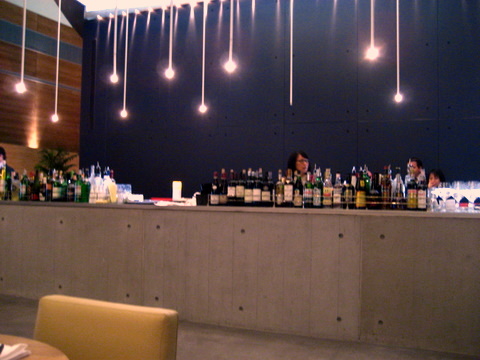
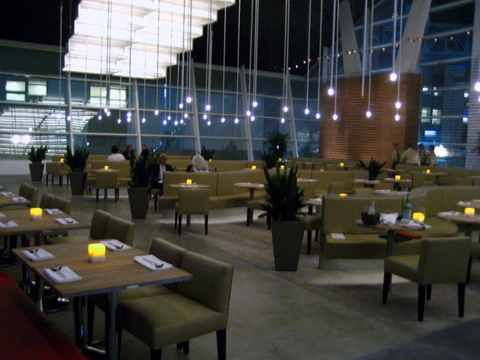
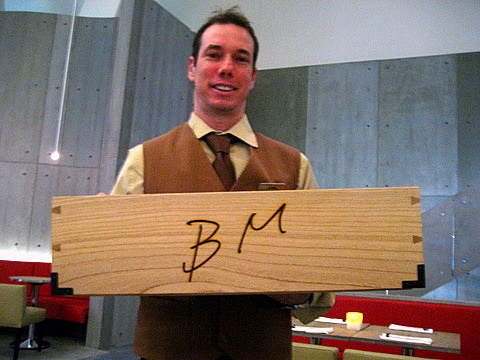
Crazy Milk, Oimatsu Shuzo, Nigori, Oita
We decided to try a variety of sakes and chose to start with a nigori (unfiltered) sake aptly dubbed Crazy Milk. The sake had a light grittiness from the sediment and a rough rustic sweetness. A very lively and effective apertif though probably less well suited to food, particularly the delicate courses that were up first.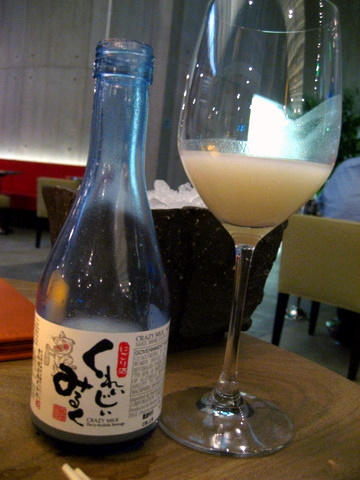
01: Tai Sea-Breem with White Truffle
Our first course was a sashimi of tai with shaved white truffle, served in a vinaigrette with baby greens. The dish came in a chilled earthenware tray that gave the fish a pleasing chill and crisp texture. As expected the floral perfume of the truffle complimented the mild whitefish perfectly. The surprise here was how well the greens worked, adding a distinct undertone of bitterness that balanced the heavier earthy notes of the truffle.

02: Ohmi Beef Tataki with White Truffle
The kitchen definitely decided to put its best foot forward and the second course continued the white truffle extravaganza; this time paired with a absurdly marbled Ohmi (Omi) Beef. Ohmi beef comes from Wagyu stock bred near Lake Biwa in Shiga Prefecture. Ohmi, along with Kobe and Matsusaka make up the holy trinity of Japanese Wagyu beef with differences between the trio arising from climate and diet. Sounds like a simultaneous tasting of the trio is in order. The beef has a silken texture and breaks apart with the ease of soft tofu again the fragrant truffles serve as the primary seasoning with the luscious beef. While the course was superb, (at $24 a piece it better have been) I would have liked a bit more cooking to bring out the natural flavor of the beef as a counterpoint for all that unctuous fat though given the tiny portion it may have been difficult to further cook the meat without overcooking it.

Kiminoi, Emperor's Well, Junmai Ginjo-Yamahai, Niigata
Moving up the refinement scale we come to our second sake a Ginjo from Niigata, a complex and flavorful sake, with a light sweetness and some rice like notes and a clean finish. Definitely much better than the Crazy Milk when paired with food.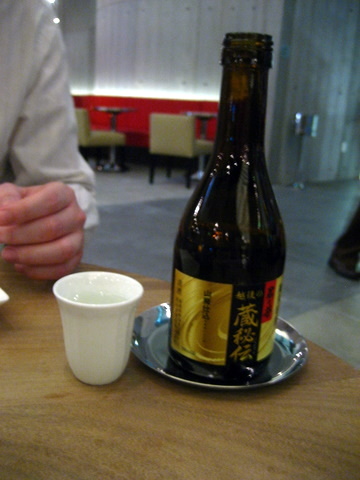
03: Sushi Canapé
The first overt service misstep occured on this course. Our waiter was a bit unclear on this course, noting that it came with 4 pieces, so we asked for two orders only to find there were really 8 pieces per order. Though this might seem like a small mistake, my companion and I make a point to try as many different courses as possible, and such unnecessary repeats are a poor use of stomach space, particularly at $48 an order. Each of the four tartares came atop a humble cucumber roll which added a crunchy element to the mix.
Toro Tartare with Caviar
A classic pairing, the fattiness of the fish is enlivened by a nutty salinity from the caviar. Inevitably the tartar doesn't have the sublime texture of a top serving of toro nigiri or sashimi but this bite was enjoyable on its own or with a drop of soy.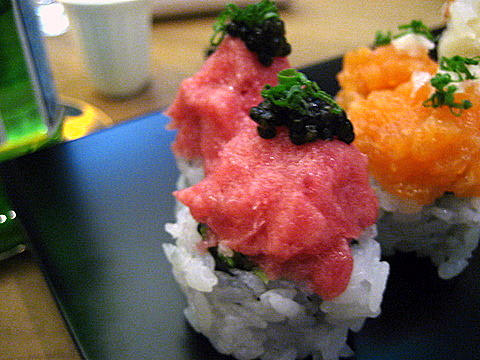
Salmon and White Onion
Another strongly flavored fish, the sweet onion combined with the fish to give this dish a Western feel. Easily the most strongly flavored, the freshness of the onion complimenting the natural richness of the salmon.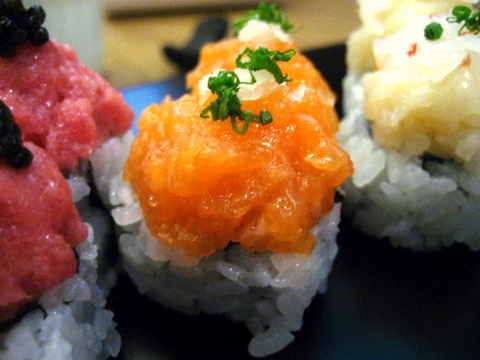
Scallop and Shrimp
Texturally this dish felt like mush though I quite enjoyed the subtly sweet combination of shrimp and scallop. Adding soy actually ruined this canapé as it masked the delicate sweetness of the shellfish.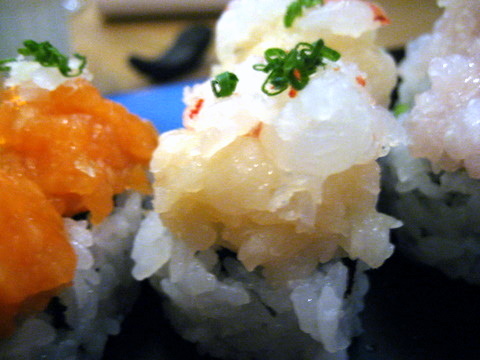
Kanpachi and Truffle
The soft flavor of the kanpachi was masked by the truffle while the diced preparation robbed the fish of any snap or resistance. A light brush of soy drew out the flavor of the fish and balanced this morsel appreciably.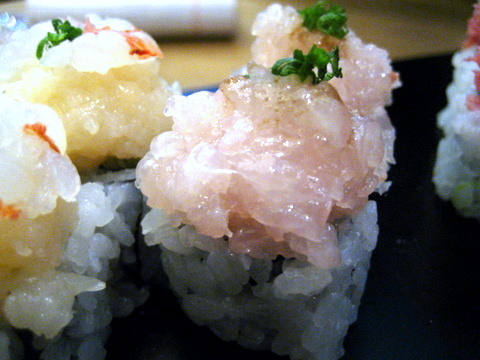
04: Seasonal Sushi Tasting
The service mishaps that began with the canapés, reached a whole new level with the sushi tasting, highlighting the disadvantage of lacking a sushi bar and direct interaction with the itamae. During my first visit to Urasawa, he asked us to eat our sushi within 10 seconds of being served. I assumed he learned this philosophy from Masa but the emphasis on speed and freshness was not apparent during our meal. First all the sushi was presented simultaneously, both the canapés and tasting arriving within a minute of one another. Secondly and more incredibly, our waiter couldn't identify the sushi he was serving us, nor could the other three staff members who came by while our request to speak directly to the chef was ignored. This whole comedy of errors took about 10 minutes virtually guaranteeing the fish wouldn't be at the peak of freshness by the time we started eating. The sushi was mostly prepared simply lacking any accouterments to better emphasize the flavor of the fish. Overall the sushi was enjoyable but for the most part lacked any distinctive touches that would make it truly exceptional.
Toro | Fatty Bluefin Tuna | Boston, Massachusetts
The toro was a well-balanced example evenly delicate throughout, there wasn't a hint of gristle or tendon. The fish had sufficient fat content to give that mouthwatering oiliness but not so much that the fish feels heavy.
Kanpachi | Amberjack | Shikoku Island, Japan
Our servers went back and for three times on this fish, unable to decide if it was Kanpachi or Hamachi. The final official word was Hamachi, but bright red stripe and the firmness of the flesh and lighter flavor led me to believe this was actually amberjack.
Tai | Sea Breem | Kyushu, Japan
We had this fish to start the meal, taken without the truffle and other accoutrements, the fish was quite clean, though it felt a bit dry perhaps the result of being left out for too long.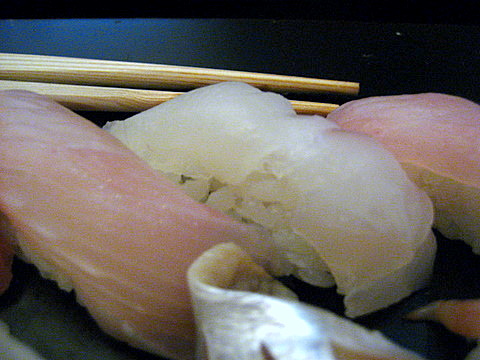
Kinme Dai | Snapper | Chiba, Japan
This was another of those fishes that took a needlessly long time to identify. We finally figured out what it was by checking the underside and spotting a spot of shimmery red skin, a dead giveaway for golden eye snapper. The few times I have had this fish, it has always been one of my favorites, having a silky ethereal body, this instance was noticably denser, still retaining some of that slickness but nowhere near as sublime as it should have been.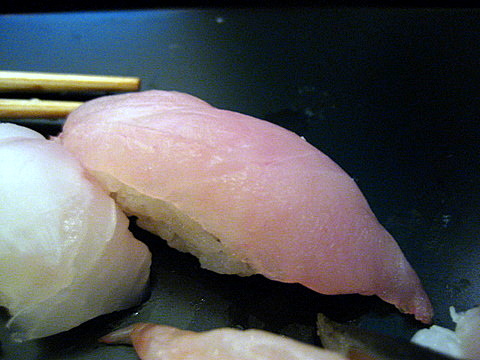
Hamachi | Young Yellowtail | Kyushu, Japan
A softer presentation of yellowtail, this was far milder and less interesting than the Kanpachi we had previously.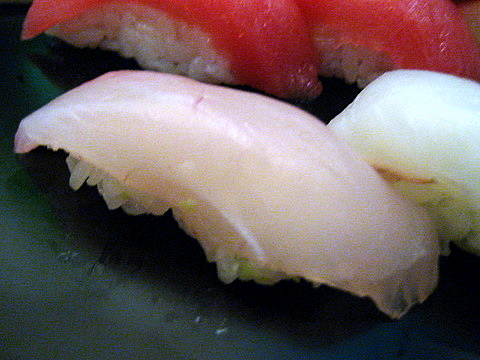
Hirame | Fluke | Wakayama, Japan
A fairly typical hirame, the soft whitefish had a mild nuttiness and desperately needed the soy to give it more flavor.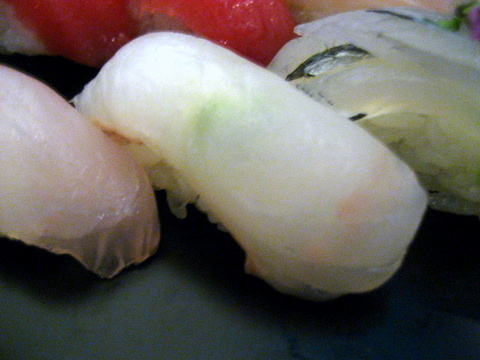
Saba | Mackerel | Miyagi, Japan
This looked like Sayori more than anything else especially with the shiso giving it that sweet fruity note. The fish had a pleasing density to it firm and solid but with only the barest hint of the rough oiliness of Mackerel.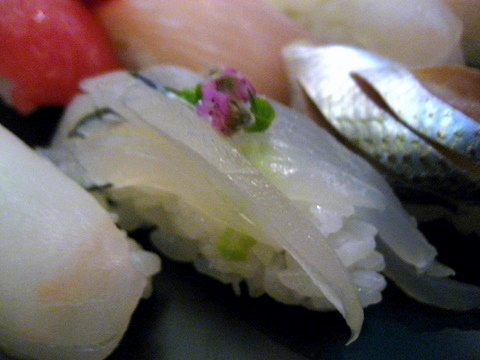
Kohada | Herring | Chiba, Japan
This was one of the fish driving the identification fiasco. Both Kevin and I thought this was Kohada but the staff insisted it was Saba. Impossible to distinguish using flavor alone, though texturally it had the dry fibrous feel of Kohada.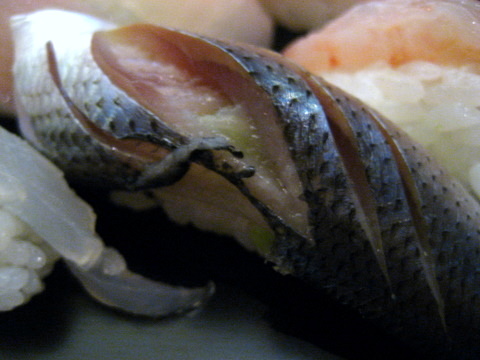
Amaebi | Sweet Shrimp | Ishikawa, Japan
The sweet shrimp looked positively anemic, not even large enough to cover the surface of the rice. With amaebi of this size there should have been at least two pieces on the rice The shrimp itself had a soft texture and mild creaminess, eminently forgettable.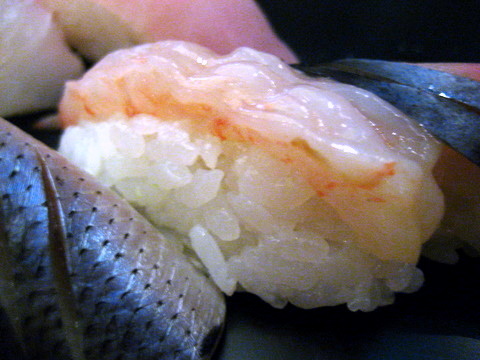
Shimaaji | Island Jackfish | Wakayama, Japan
Shimaaji has long been a favorite and with this piece, the light translucent color and supple texture belie the intensity of the characteristic mackerel fishiness.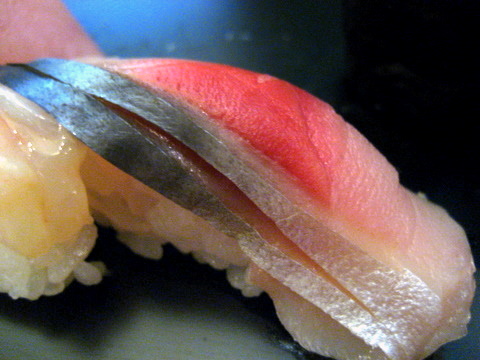
Akami Maki and Cucumber Maki
The sushi ended with a duo of maki rolls. The first consisted of a meaty bite of clean lean tuna wrapped with a thin layer of rice and nori; a lovely study in textures. Next up was a cucumber roll that possessed a refreshing crispness enhanced by a generous sinus stinging helping of wasabi.
05: Calamari with Jalepeño Salt
We decided to try a couple hot appetizers to see how well the kitchen handles hot food. I've never really been a fan of calamari but it is a safe choice and my companion has a soft spot for the stuff. The squid was nicely fried with a light clean flavor and good salinity. The jalepeño slivers added tiny pinpricks of heat but could have been more apparent. Enjoyable but not particularly memorable.
06: Popcorn Shrimp with Romesco Sauce
As with the fried squid, the shrimp was competently fried, bearing an even coating of light golden batter. Unlike the squid, the shrimp was far too soft lacking any sort of textural character and extremely bland to boot. The shrimp is served with a Romesco sauce which hails from Catalonia and consists of a blend of almonds or hazelnuts, garlic, olive oil, and dried red peppers. The smoky sweetness of the sauce and vegetal tang of the greens added some much needed flavor to the fried shrimp.
07: Uni Risotto with Black Trumpet Mushroom
The last hot course was an uni risotto, that came out piping hot and looking for all the world like the result of too much binge drinking. This course could also be tarted up with white truffle for an extra $30. We decided to forgo truffles as uni has more than enough natural flavor. The risotto turned out to be the most disappointing course of the night. Drastically unbalanced, there was far too much sea urchin for the sushi rice "risotto." Moreover, the cooking process robbed the roe of its sweet flavor profile while enhancing the brininess. Lastly the roe was broken up into a mushy mass making it impossible to enjoy creamy texture normally associated with uni.
Ginga Shizuka (Divine Droplets), Takasago, Junmai Daiginjo-Shizuku, Hokkaido
The last sake was a Junmai-Daiginjo. easily the most refined of the three with a subtle floral bouquet and clean light flavor. The Shizuku appellation means the unfiltered sake is allowed to drip naturally from the rice rather than being pressed dramatically increasing the amount of time it takes to produce.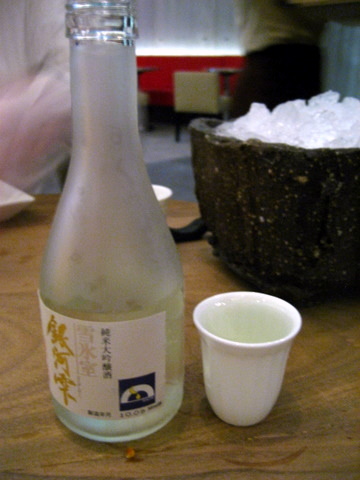
08: Naked Oyster in Citrus Sauce
This was actually the first course we ordered and I suspect our server forgot about it though in his words, he didn't put in the order because "he wasn't sure if we wanted it." We inquired after the oysters when ordering more courses and it came out quite promptly. When our waiter brought this course out, the stinging funk of the shredded daikon hit me like a physical blow. The sprouts were absolutely vital in tempering the harshness of the radish. I suspect the oysters were Hama-Hamas, with their plump meaty texture and mild natural sapor, A stronger oyster like a Kumamoto, would have stood up to the acidity better.
09: Akamutsu | Fatty Deep-Sea Snapper | Chiba, Japan
A very subtle fish, with the clean snappy texture of snapper softened appreciably by the added fat. The mild flavor of the fish is acceted by a light richness reminicsent of yellowtail.
10: Yari Ika with Salt and Yuzu Zest | Sea Eel | Chiba, Japan
I had a wonderful experience with Yari Ika (Spear Squid) at Raku so I was eager to see what kind of magic Masa could work with it and I wasn't disappointed. The slick supple texture yielded a sweet creamy flavor that was brightened appreciably by the yuzu zest and rock salt. This course involved another service mistake but finally one in our favor, as the kitchen sent out an extra piece of squid.
11: Tako with White Truffle Sauce | Octopus | Chiba, Japan
The last savory course was octopus sashimi again topped with white truffle. The octopus had a rougher chew than the refined squid we had previously and the mild flavor lent itself well to the truffle accents.
12: Grapefruit Granité with Cointreau and Grand Marnier
The restaurant supposedly had two desserts earlier in the evening but ran out of the other leaving us with a simple grapefruit granité. The granité tasted of fresh grapefruit on the attack and ended with a citrus bitterness. I quite enjoyed the bracing chill of the dish though my companion found the sensation jarring. The liqueurs were almost invisible except perhaps as an accent to the bitter finish and providing a slight heat on the finish. Enjoyable but I would have liked something more substantial to follow.
When we started the meal we asked if Masa was at the restaurant and were suprised to find that he wasn't; though he would show up later in the evening. About two thirds of the way through the meal, Masa came by to check up on us. I expected him to be stoic and traditional but he proved to be easy to talk to. We were able to have a short chat with him and snap a photo before he went to tend to other guests.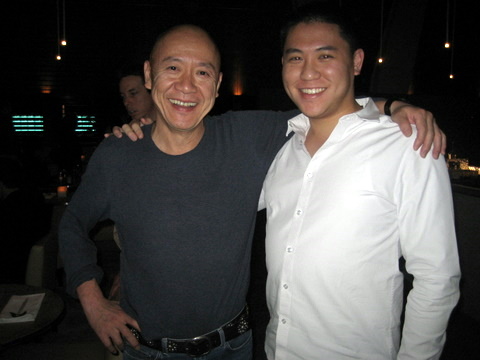
The meal came out to $465 per person all inclusive, with food accounting for $316.5 of that. After looking at the menu of Bar Masa New York I was prepared to spend $500+ on food, however the restaurant was offering an abbreviated menu to start which resulted in the lower damage. Though I enjoyed the food at Bar Masa, I couldn't see the same care and effort that goes into every bite at Urasawa as exemplified by numerous service debacles, from missing orders, to the madness that was identifying the fish in the Sushi Tasting. Certainly I understand the restaurant caters to a different crowd, lacking a sushi bar and true omakase while offering both cliched and exotic offerings. Still with a final price comparable to Urasawa I don't think I am unreasonable in expecting a more personalized service. Being situated in Vegas only exacerbated the douchebaggery of the clientele, with Spicy Tuna Rolls and California Rolls aplenty at the tables around us. Though I hoped to gain some insight into Masa's style, it looks like I'll have to visit Masa's flagship outpost in New York to make any gainful comparison or at least Shaboo whenever it opens.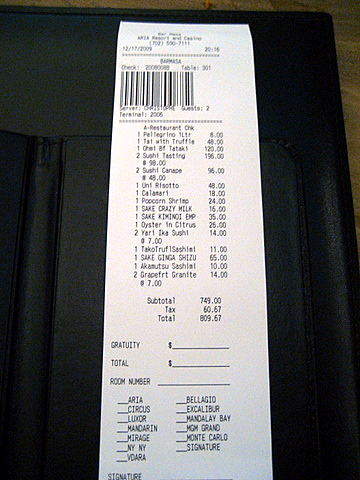
Friday, December 18, 2009
Bar Masa - 12/17/2009
Subscribe to:
Post Comments (Atom)
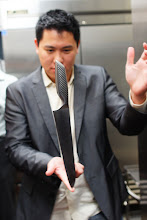
2 comments:
that meal just doesn't look very good. don't let it reflect on Masa (NYC); however, after 2 visits to Tokyo now, i say go to the source.
I am definitely still game to try Masa in NYC. Though I recall you seem to favor Urasawa to Masa on your list of favorites.
Post a Comment